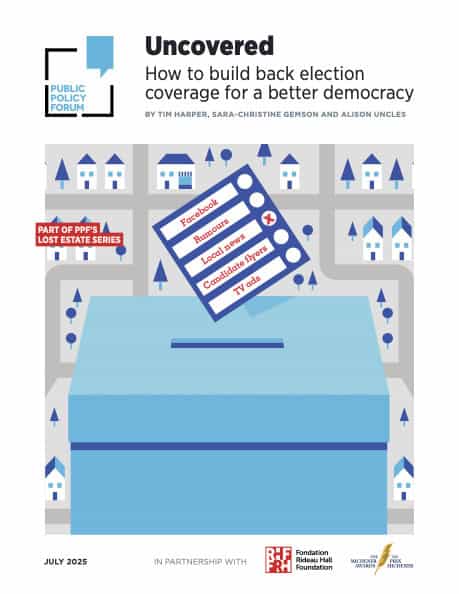A rapidly formed philanthropic collaboration during an important election campaign offers some lessons about how philanthropy might support local journalism in the future.
On March 24, 2025, Prime Minister Mark Carney called what proved to be a pivotal election: a high-stakes debate about leadership, trade, and foreign policy in an extraordinary moment.
The next day, on March 25, Joyce Webster, publisher of the East Central Alberta Review, admitted to a “roller coaster of emotions” as she published the last issue of the 114-year-old newspaper, succumbing to the same forces that have buried news outlet after news outlet over recent years.
There’d be one less local news outlet covering the election, and one more community not getting the essential information it needed. “I can’t tell you how sad I am for ‘community’ because I know community newspapers are the glue that keeps communities informed, connected and engaged, unlike social media which seems to fragment communities,” Webster wrote in her final publisher’s note. “There are hundreds of newspapers across North America that have closed their doors in the last decade with the East Central Alberta Review joining the list.”
Webster’s paper joins a long list of local news outlets in Canada that have either closed their doors in recent years or been largely gutted by chain ownership. The Lost Estate, a recent Public Policy Forum (PPF) report produced in partnership with the Rideau Hall Foundation (RHF) and the Michener Awards Foundation (MAF), outlined the problem: “More than 340 communities have lost local news providers since 2008, and the trend isn’t relenting,” the report notes. “The cutbacks, shutdowns and general hollowing out have reached the point where the only thing left in some places is a ‘ghost paper’ – a familiar masthead but with little or no local news in the local product. Each year, more news outlets fall victim to the collapse of traditional media business models.”
Another recent report showed that 2.5 million Canadians now live in news-deprived areas, with access to only one – or no – local news outlet. The well-documented long-term effects of a diminishing local news ecosystem range from a lack of information about institutions such as courts, hospitals, and schools to far deeper impacts, including a loss of caring for one another.
But the short-term impact on an important election campaign was urgent. Many outlets wouldn’t have the resources to cover what was increasingly being dubbed the most important Canadian election in a generation – if not ever. Dwindling freelance budgets, non-existent travel budgets, and the onerous daily demands of keeping the lights on were likely to mean that even well-meaning journalistic ambition during the campaign would likely give way to simple survival.
And then, a key moment. André Beaulieu, chairperson of PPF’s board of directors, and Greg David, executive chair of the Rossy Foundation, found themselves deep in conversation about the media’s capacity to cover the election. Given the stakes, responsible, fact-based reportage was more important than ever. Some journalism enterprises, particularly small and medium-sized ones, simply could not afford to travel to cover candidates and campaign events, or to spend the time necessary to delve into deeper policy issues.
We knew that if we were to have any impact at all, we had to move at lightning speed.
André Beaulieu, Public Policy Forum
How could Canadian democracy be strengthened by increasing reputable, fact-based coverage of the federal election campaign? What could be done to help? “We had almost no time; our conversation happened the Friday before the Sunday election call,” Beaulieu recalls. “We knew that if we were to have any impact at all, we had to move at lightning speed.”
What followed over the frenzied week that followed gives a bit of hope for local news, democracy, and the future of journalism in Canada – and teaches us some lessons about how philanthropy might support local journalism in the future.
Lesson one: Trust is necessary
The exercise was rooted in trust and familiarity between partners who had worked together – Beaulieu and David, and also PPF, RHF, and MAF, which had recently collaborated on The Lost Estate report.
This was a wonderful example of partnership and co-creation, built on a foundation of trust, alignment of vision, and willingness to take risk and move quickly.
Inez Jabalpurwala, Public Policy Forum
As the election campaign was already underway, time was of the essence; decisions were made quickly, with handshake agreements the order of the day. “This was a wonderful example of partnership and co-creation, built on a foundation of trust, alignment of vision, and willingness to take risk and move quickly,” says Inez Jabalpurwala, president and CEO of PPF. “We were able to not only launch an important fund for journalists – and democracy – at a crucial moment, but also produce a landmark report about the effort that has set the stage for future philanthropic efforts.”
Lesson two: Speed is possible
Over dozens of phone calls, Zoom meetings, and emails, a non-partisan grant program began to take shape. Only six business days after the initial Beaulieu-David conversation, the Covering Canada: Election 2025 Fund was launched.
PPF created and led the fund, pulling together a written proposal that was circulated to foundations, with follow-up calls and, in some cases, formal applications for funding that were then approved and disbursed almost immediately.
RHF set up and managed an application process and coordinated a panel of judges from MAF, which volunteered to judge the submissions. Criteria were quickly set, including a guideline that the outlet be a registered “qualified Canadian journalism organization” or equivalent, to establish a bar of quality and professionalism.
“The goal of the Covering Canada Fund was to help cover community stories that otherwise might not have been told,” says Teresa Marques, RHF’s president and CEO. “And to do that, we needed to ensure the funds be dispersed quickly and efficiently, and yet in a thorough and rigorous way, to support smaller local newsrooms, public-service journalism, and Canadian democracy all at the same time.”
The goal of the Covering Canada Fund was to help cover community stories that otherwise might not have been told.
Teresa Marques, Rideau Hall Foundation
In the end, the fund, powered by a lead gift from the Rossy Foundation, included donations from the Donner, Echo, Gordon, and Metcalf foundations for a total of $525,000.
“Although Echo Foundation’s two areas of interest centre on mental health and the environment, we understand the importance journalism plays in informing the electorate about these issues,” says Kevin Leonard, executive director of the Montreal-based Echo Foundation. “We were pleased to contribute.”
Jamison Steeve, executive director of the Metcalf Foundation, agrees: “A pooled fund de-risked things. This was a discrete, time-limited effort with specific outcomes. I was an immediate and enthusiastic ‘yes.’”
Lesson three: Don’t ‘boil the ocean’ – keep it simple
Local journalism is in crisis across Canada; the underlying problems are large, intertwined, and seemingly intractable. But this grant program was clear and specific about the problem foundations could help address. It was relatively small. It was fast. It was catalytic.
Applying for the grant was easy, too. Grant recipients needed to show how their work would add material additional benefit to the journalistic coverage of the election, providing assurance that funding would not be used as a simple replacement for missing advertising revenue. Seventy-nine applications from across the country were received in the first three days, and grants were quickly provided to 40 media organizations.
Thanks to grants that ranged from $2,500 to $35,000, ambitious journalism blossomed almost instantly: the Nunatsiaq News in Iqaluit sent a reporter to Grise Fiord on Ellesmere Island, Canada’s northernmost community; La Liberté in Manitoba quickly hired three journalists for the campaign and produced 32 stories, including on-the-ground reporting from Churchill and expansive coverage of all 14 of the province’s ridings; Energeticcity.ca, which serves Fort St. John and northeast BC, sent reporters hundreds of kilometres to cover all-candidates meetings in Prince George and Fort Nelson.
The independence we were given to do our work – without interference or cumbersome paperwork – should be a model for how public-service journalism is supported in this country.
David Skok, The Logic
“I’ve worked in journalism for over 25 years and have collaborated with numerous foundations and granting organizations,” says David Skok, CEO and editor-in-chief of The Logic, a grant recipient that sent reporters across the country. “Without hesitation, I can say that our experience with the Covering Canada: Election 2025 Fund was one of the most effective and journalistically respectful initiatives I’ve encountered. The independence we were given to do our work – without interference or cumbersome paperwork – should be a model for how public-service journalism is supported in this country.”
Lesson four: There’s something for everyone
In Uncovered: How to Build Back Election Coverage for a Better Democracy – a PPF report released in late July in partnership with RHF and MAF – we recommended the creation of a permanent, non-partisan election fund in the spirit of the Covering Canada experiment, which demonstrated clear demand on the part of media outlets, and also a supply of willing donors.

Key to the permanent fund’s success would be non-partisanship and independence, of course, but also top-tier application judging that is beyond reproach.
Some donors may prefer discrete, time-stamped efforts, such as the election fund we propose. Others may be more inclined to support much-needed operational funding for local news outlets of the sort that Toronto-based Inspirit Foundation is pulling together. (Inspirit, a charitable foundation that promotes pluralism, is spearheading a pooled philanthropic fund to provide ongoing support for journalism in service of underserved communities. At last count, Inspirit had pulled together four foundations to support the effort and has a goal of $5 to $8 million to fund a five-year pilot program.)
Local news outlets must also do their part to create a diversity of funding for themselves that includes advertising, subscriptions, events, tax credits – and philanthropy. In particular, they need to give philanthropy a clear role in this nation-building project and build attractive vehicles for them.
A permanent, non-partisan election journalism fund is a start.


